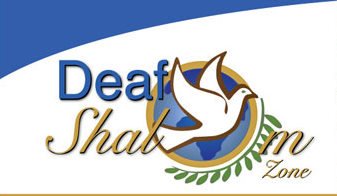BARBARA DUNLAP-BERG
United Methodist News Service
The Rev. Kirk VanGilder was born Hard of Hearing. At school, he said, “I was continually made to feel different, strange and ‘not normal’ by kids who noticed my hearing aids or giggled when I had to ask the teacher to repeat something.”
When he discovered Deaf culture and community, VanGilder realized there simply was something different about him.
“Far from needing to be ‘fixed,’” he said, “that difference of being deaf was a gift from God … a language, culture and way of being that honored how I was made and contributed to the world around me.”
As his ability to hear declined, VanGilder transitioned into using American Sign Language (ASL) in college and seminary. Today he is assistant professor of religion at Gallaudet University in Washington.
LaSander Saunders experienced hearing loss as an adult. “Because my Deafness was gradual,” she explained, “I was constantly faced with the need to do something about it. I struggled with depending on others. When I decided to further my education, I began to learn (ASL).”
Christ Deaf United Methodist Church in Baltimore was a refuge for Saunders. Today she is a leader in that congregation and in her annual conference, with church choir directing and lay speaking among her many contributions.
“I found a place of worship and identity with people I had something in common with,” she said. “I was blessed to have this life-changing experience and be accepted.”
“My parents are Deaf and my first language is ASL,” said the Rev. Leo Yates. His family attended the former Washington United Methodist Church of the Deaf in Takoma Park, Maryland. “Being in Deaf ministry was ingrained in me since childhood. Being bilingual and bi-cultural, it is natural for me to bridge hearing and Deaf individuals.”
Closing a gap, opening doors
VanGilder, Saunders and Yates are among the few members of the Deaf community who have found welcome in any church. Of the approximately 32,000 United Methodist congregations in the U.S., fewer than 200 have any accommodations for Deaf people who use ASL, said Carol Stevens, a lifelong United Methodist and a certified ASL interpreter.
Today, however, the denomination is working to close the gap between hearing and Deaf communities through the United Methodist Committee on Deaf and Hard-of-Hearing Ministries. A recently released ASL video glossary “is a significant step in opening the doors of The United Methodist Church to the community whose primary language is ASL,” said Michelle Provart Menefee. A certified ASL interpreter – next year’s General Conference will be her third in that role – she is a lifelong United Methodist.
In autumn 2014, the Rev. Tom Hudspeth, president of the United Methodist Congress of the Deaf and pastor of Deaf ministry at
Lovers Lane United Methodist Church, Dallas, approached Menefee about taking on a project to develop a resource of United Methodist terms in ASL for interpreters.
“I said, ‘YES!’” she recalled. “Then I took a couple steps, looked up to heaven and said, ‘We can do this.’ From that moment, I began praying for a clear vision on how this project should be developed. I prayed for the right people in the right places to make this work worthy. Most importantly, I prayed that when it was done, all the glory would go to God.”
Patricia Magyar, top executive of U.S. health for the General Board of Global Ministries and liaison to the United Methodist Committee on Deaf and Hard-of-Hearing Ministries, set up a conference call with Tim Tanton, a staff executive at United Methodist Communications. “I shared a starting goal,” Menefee remembered. “Then the Holy Spirit took over the call. A conversation began, and a new vision was born.”
The resulting ASL video glossary, with Deaf people signing a lexicon of religious terms with explanations as well as the Lord’s Prayer and the Apostles’ Creed in sign language, is now available on The United Methodist Church website and available via YouTube and other social media.
‘Unprecedented work’
“This is unprecedented work on behalf of the Deaf community,” said Bishop Peggy A. Johnson, Philadelphia Area, who previously served Christ Church. “With increasing mobile Internet use, this kind of resource can be accessible to all people – hearing people trying to learn sign language and Deaf people wanting to understand the theology better in their own language.”
A six-member team translated The United Methodist Church glossary definition from English to ASL. They included two United Methodist clergy from the Deaf community (VanGilder, vice president, United Methodist Congress of the Deaf, and Yates), two Deaf laypeople (Saunders and Topher Gonzalez, 22, and a recent college graduate) and two United Methodist interpreters (Stevens, who learned ASL as an inner-city nurse 50 years ago, and Menefee).
The videos show the common signs for a term and explain the concept.“It is a teaching tool for Deaf people to understand the concepts and for interpreters to know how to interpret and expand the information as part of the interpretation for clarity or meaning,” Stevens said.
“Sign languages are not universal,” she pointed out. “At Christ Church, we work with Deaf people from 40 countries – often with immigration issues and all from countries with different sign languages.”
Menefee noted, “American Sign Language is not English in signs. The two languages are very different in syntax, grammatical structure and other ways.”
Yates believes the glossary will prove invitational.
“We hope this will further help the Deaf community to fall in love with what The United Methodist Church offers,” he said. “This signed glossary provides the viewers to see what The UMC is about.”
A combined grant from the United Methodist Committee on Deaf and Hard of Hearing Ministries and the Deaf and Hard of Hearing Ministries Advance Special funded the project.
Last Updated on October 20, 2023

